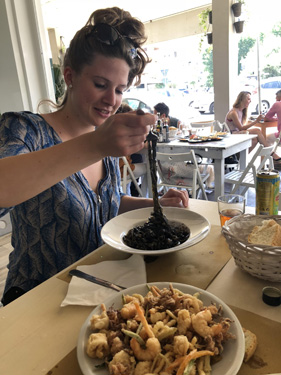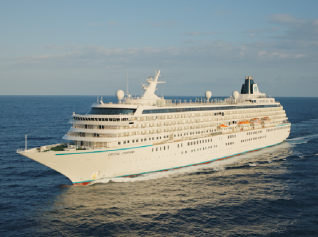Tasty tourism rising rapidly

Frances testing Fettuccine al nero di seppia
Food Consumption is a Major Sustainable Touristic Experience says Frances Salvoni
Aside from being one of the most fundamental physiological needs of humanity, food and eating is rapidly gaining recognition as an essential cultural element and attraction offered by tourist destinations.
Consuming local cuisine can enhance or even be a central element of the overall visitor experience. The idea that food and culture are inherently linked has been highlighted by the UNWTO and destinations are increasingly recognising the significance of gastronomy in stimulating sustainable economic development at local, regional and national levels.
Gastronomy is now a pivotal feature of the overall tourist experience, which has led to destination management quite literally catering their marketing and product development strategies accordingly. Food tourism can stimulate repeat visits to destinations in attempt to replicate tourists’ previous culinary experiences as well as inspire travel to new places in search of distinctive and enticing flavours unfamiliar or otherwise different.
Tourists’ growing love for local produce means destinations can utilise their unique cultural heritage to appeal to travellers looking "to feel part of their destination through its flavours", says the UNWTO; resulting in the conservation and sustainability of cultural attributes characteristic to a destination. By ‘tasting a place’, tourists are able to expand their understanding of food as well as immersing themselves into another culture.

Gelato in Italy
Through the act of consumption, tourists can embed themselves in a multi-sensory journey through experiencing first-hand something special and unusual – not only taste but sight, sound, scent and touch! Food and eating goes beyond being enjoyable and necessary sustenance in tourism, where it is often considered "a marker of social distinction" and a significant way to encounter and experience other cultures through the domain of food.
However, although food experiences form an integral and pleasurable component of many tourists’ travel itineraries, others see eating as a minor feature of their overall travel experience; a necessity purely to satisfy hunger whilst they explore other prominent destination interests.
Since food began to appear on UNESCO World Heritage Lists in 2010 it has developed into an essential motivator for many tourists’ travel to particular destinations to experience the ‘spirit’ of a place; a form of cultural heritage where elements of difference away from normality are sought.

Frances checking Tagliatelli al Ragu in Bologna
Tourism is a way of engaging with diversity in much the same way as sampling ‘foreign’ cuisine is a way of really experiencing it. If a typical tourist experience involves partial engagement of the senses, such as through sightseeing; culinary tourism offers a far deeper level of experience. Using more than simply vision, as is the predominant sense within regular tourism, the integration of smell, touch and taste through food engages visitors’ active participation in the whole experience rather than just being bystanders. As a culinary tourist, a change in usual consumption habits is not so much to satiate hunger as it is to experience other cultures and ways of being.

Buying fresh home grown green figs
Falling on the lower end of today’s emerging ‘Food tourist’ spectrum are those who have little or no interest in food during their travels. For these ‘regular’ tourists, their food-related visits may include dining at a familiar restaurant because they must eat; or visiting a market or store because they consider it something different to do. Their primary reasons to travel do not usually incorporate specialist or local delicacies – any special culinary experiences they partake in are usually impromptu.
Today’s growing market are the ‘Culinary Tourists’ – those whose major motivation for travel to a particular destination is for the food and beverages, or food-related events.
And at the peak of the foodie scale are the ‘Gastronomic Tourists’, where food and food-related activities are deemed a form of ‘serious leisure’ and where food is very much an attraction in its own right. For these tourists, a destination’s cuisine is of greatest priority in the overall quality of their touristic experience.

La crescia sfogliata di Urbino
Of course, consumption is integral to the full tourism experience. Not only the physical consumption of food but also the consumption of sights and sounds which reflects the overall character and ‘taste’ of a place.
Tourists are usually influenced to travel by ‘push and pull’ factors. Push factors result from demand and are the cause behind tourists’ travel to destinations, whereas pull factors consist more of external resources such as distinctive cultural and natural attractions inherent to a destination. According to the UNWTO, cuisine can provide tourists access to the historical and cultural heritage of destinations. In consuming food through tasting, experiencing and purchasing; culture is approached in a more experiential and participatory way.
Since food can incorporate so much more than just the act of its consumption, culinary tourism can also encompass an exploration of other aspects of food systems. The new can be mixed with the old, such as obtaining well-known ingredients from new places; and the exotic can be mixed with the familiar, for instance by adding or substituting different ingredients to dishes. In addition, physical travel is no longer an essential component for being a culinary tourist – simply by visiting a restaurant serving ‘different’ cuisine, without the need to cross any borders, can signify culinary tourist motives.
Food has the capacity to transcend being a basic yet fundamental human requirement into a cultural attraction, and a quintessential element of both tourism production and consumption.

Checking Tiramisu
The production of distinctive and local food has developed into an essential component of a destination’s attributes and basis for tourist experiences, creating invaluable opportunities for local and sustainable tourism. More people are now able to experience ethnic or otherwise ‘foreign’ foods without leaving their homes and, as mentioned above, by dining out or visiting such places one may be considered a culinary tourist just as much as those physically travelling to new destinations.
Eating can be considered a social act and a way in which to satiate curiosity; through a willingness to experience the cultural worlds of other people and a desire to learn about other experiences and ways of life.
Food is a powerful medium through which other cultures can be discovered, where identity, relationships, ideologies, and emotions can be communicated, and the fulfilment of basic physical needs can be met. However, there is another and less oft-explored component of food in tourism which represents the phobic tendencies of tourists; those who are fundamentally afraid of the unknown in terms of new and unfamiliar foods. It is thus through food that the capacity of expanding cultural understandings and touristic encounters can be met.
It is important therefore to think about culinary tourism from the varying perspectives of tourists and the ways in which food can support and enhance sustainable tourism. In this way; "tourism is in the eye of the beholder – or on the tongue of the taster".
 United Kingdom
United Kingdom United States
United States Asia Pacific
Asia Pacific












































BA suspending all Heathrow to Abu Dhabi flights
Turkish Airlines flight in emergency landing after pilot dies
Unexpected wave rocks cruise ship
Woman dies after going overboard in English Channel
Foreign Office issues travel advisory for winter sun destinations